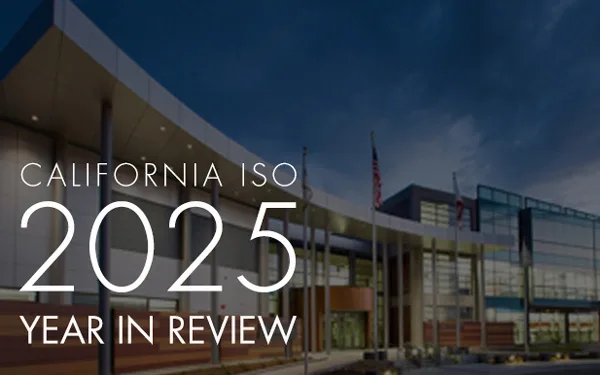Momentum and Shared Progress – An overview of the 2024 Symposium
Editor’s Note: If you were not able to attend in person or remotely, you can watch recordings of the ISO’s 2024 Stakeholder Symposium.
What a difference two years makes.
When the California ISO (ISO) held its 2024 Stakeholder Symposium in downtown Sacramento October 30 with 950 in-person participants and another 500 online attendees, circumstances were considerably different from the same event two years earlier.
“A ton has changed since our last Symposium in 2022 and the theme of today is to highlight the many positive steps we’ve taken together as a Western energy community with respect to market evolution, transmission development and governance,” Elliot Mainzer, president and CEO of the ISO, said before introducing the first panel of Western energy leaders.
“We’ve had two years of remarkably reliable grid operation performance,” Jan Schori, chair of the ISO’s Board of Governors, said in her welcoming remarks.
She also noted that the grid now has more than 10,000 megawatts of battery storage that can be dispatched to keep the system balanced during hot summer evenings. Overall, from November 2022 to October 2024, 11,876 megawatts of new power has been added to the California grid.
In their upbeat welcome, Schori and Robert Kondziolka, Chair of the Western Energy Markets Governing Body, went through a list of other big advances over the past two years:
- Federal regulatory approval for the ISO’s Extended Day-Ahead Market (EDAM), a reformed interconnection process and a new subscriber model making it easier to finance big transmission projects;
- More market participants and an expanding footprint for the Western Energy Imbalance Market and Extended Day-Ahead Market. Major progress on independent governance for Western energy markets managed by the ISO and more.
Much of the morning was focused on progress by the West-wide Governance Pathways (Pathways) initiative, an effort to establish a regional organization to oversee wholesale electricity markets across the West. Kathleen Staks, Director of Western Freedom and a Co-Chair of the Pathways Launch Committee, led two panels: one covering the proposal and next steps and another on the perspective of regulators. The third part of the Pathways discussion was a conversation between Mark Rothleder, the ISO’s senior vice president and chief operating officer, and Pam Sporborg, Director of Transmission and Market Services for Portland General Electric, on the ISO’s perspective on Pathways.
Not seen in previous efforts to create a regional market, labor union and public power leaders expressed support for making changes to California statutes that would enable oversight of the markets by an independent regional governing board.
Kevin Thompson, a commissioner on the Arizona Corporation Commission who has served on the Pathways Launch Committee, said a broader market footprint and greater sharing of generating resources and transmission will be beneficial across the West.
Next up was a panel on transmission moderated by Rob Gramlich, one of the top transmission experts in the country. Joined by four transmission developers and Maria Robinson, Director for the Grid Deployment Office at the U.S. Department of Energy, the group discussed some of the new innovative approaches to planning and building transmission that have advanced in the past few years.
In addition to the need to deliver historic amounts of new sustainable energy, a big driver of the need for more transmission has been heightened demand for electricity from the rapid growth of large data centers, more electric vehicles and electrification of the building industry.
Kicking off the afternoon sessions, the ISO’s Mainzer and Brian George, a global energy market policy and development leader at Google, had a wide-ranging conversation about artificial intelligence, “the data economy” and its future impact on the grid. Among other things, George said, having enough transmission infrastructure is essential to realize the economic development opportunities associated with artificial intelligence.
“There is a tremendous amount of optimism in the West right now,” George added. “The appetite for organic engagement across a broad set of stakeholders to really dig in and find solutions, that’s special. That doesn’t exist everywhere, and so now is the time to lean into that.”
Lisa Grow, president and CEO of IDACORP and Idaho Power Company, moderated a panel on evolving western markets with panelists Cindy Crane, CEO of PacifiCorp; Tracey A. LeBeau, administrator and CEO of the Western Area Power Administration; Dawn Lindell, general manager and CEO of Seattle City Light; and Caroline Winn, CEO of San Diego Gas & Electric. The session was preceded by a short video commemorating the market’s 10 years of growth and success.
The panel conversation revolved in large part around how fully integrated Western markets save costs, enhance reliability and reduce greenhouse gas emissions. LeBeau also touched on her company’s recent announcement that after a year participating in the WEIM, the Sierra Nevada region of the Western Area Power Administration is now pursuing final negotiations toward full participation in EDAM.
“There’s no better time to be addressing energy affordability, there is no better time to be talking about reliability and resiliency of our grid,” Winn of San Diego Gas & Electric said. “With all of the clean energy coming out of the grid, we need each other. Stuff is going to happen . . . “We’ve dealt with the wildfires. We’ve dealt with having to take transmission lines out. We’ve dealt with rolling blackouts. We know the impacts.”
The last panel of the day was on demand response, virtual power plants and the role they are playing – and can play in the future – on reducing demand for power from the grid. With technology to enable electric vehicles, smart thermostats and even refrigerators to help manage consumer energy use, demand response has tremendous potential with the right, fully automated and supported programs.
“One of the few downward pressures on rates is taking advantage of the grid that we have and optimizing its use by flexing load at as big a scale as we can get,” Andrew McAllister, Commissioner with the California Energy Commission, stated.
Panel moderator Bryan Hannegan, President and CEO of Holy Cross Energy in Colorado, closed by explaining the potential economic impact and cost savings for consumers and utilities that could be achieved through home connectivity and behavior change when he put the opportunities associated with demand response – and the challenges – in perspective.
“But as you’ve heard in the last hour, we’ve got challenges with standards, with interoperability, with interconnection, with price signals, market rules, access to data, making sure we do it from the customers’ perspective especially with equity,” he said.
In addition to the vibrant panel discussions that captivated an engaged audience, the lobby during the Symposium networking breaks was alive with energy. It buzzed with heartfelt reunions among former colleagues, the excitement of meeting new people, and the opportunity to mingle with members of the ISO’s Board of Governors and the Western Energy Markets Governing Body.
Once again, this year’s Symposium demonstrated how so many remarkable people in the industry are driving its success and innovation. The ISO appreciates all the event sponsors and everyone who participated. Thank you all for making this year’s Stakeholder Symposium so memorable and productive.


